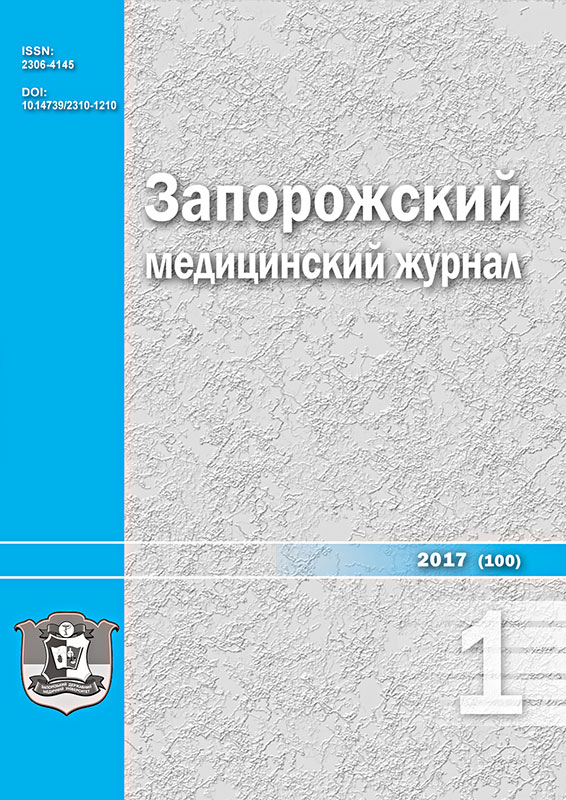Elastic properties of pulmonary artery in chronic obstructive pulmonary disease
DOI:
https://doi.org/10.14739/2310-1210.2017.1.91617Keywords:
pulmonary artery, elasticity, chronic obstructive pulmonary diseaseAbstract
Today chronic obstructive pulmonary disease (COPD) is one of the most common diseases with specific pulmonary vascular changes.
The aim – to evaluate elastic properties of pulmonary artery (PA) and pathogenic mechanisms of disorders in COPD.
Materials and methods. Participants were 50 patients with COPD stages 1–3 without comorbidities (32 men and 18 women, average age was 49.8 ± 1.0 years). Control group included 30 healthy people (19 men and 11 women, aged 50.1 ± 1.2 years). PA elastic properties was researched by ultrasound method. Statistical analysis was performed by means of the Statistica® 6.0 for Windows (StatSoft Inc.) software using parametric and nonparametric methods.
Results. Study data showed that pulmonary arterial pressure (PAP) and PA elastic properties were significantly different between subjects with COPD and control group. Thus, pulsatility, compliance and distensibility in CORD were decreased (39.23 ± 1.6 %, 6.4 ± 0.4 mm 2/mmHg and 1.71 ± 0.10 %/mmHg versus 51.4 ± 1.9 %, 11.1 ± 0.5 mm 2/mmHg and 3.30 ± 0.12 %/mmHg in control group, respectively, p < 0.05), and elastic modulus and index stiffness B were increased (65.7 ± 3.7 mmHg and 2.91 ± 0.17 to 31.6 ± 1.2 mmHg and 2.05 ± 0.08, versus 31.6 ± 1.2 mm Hg and 2.05 ± 0.08 in control group, respectively, p < 0.05). Analysis in groups divided by severity of COPD showed that PA elastic properties was not different significantly between subjects with COPD stage-1 and control group. However, several significant differences in PAP and PA elastic properties between subjects with COPD stage-2, COPD stage-3 and control group were found (p < 0.05). Pearson correlation analysis was showed significant relationships between indexes of PA elastic properties and FEV1, indexes of PAP.
Conclusions. The changes of PA elastic properties in COPD are accompany by increasing stiffness, thus reduce pulsatility, compliance and elasticity of vascular wall. Detected changes of PA elastic properties were associated with disease progression, airflow limitation and pulmonary hypertension, most significantly in COPD stage-3.
References
Feshchenko, Yu. I., Yashyna, L. O., Dziublyk, O. Ya., et al. (2013) Khronichne obstruktyvne zakhvoriuvannia lehen: etiolohiia, patohenez, klasyfikatsiia, diahnostyka, terapiia (proekt natsionalnoi uhody) [Chronic obstructive pulmonary disease: etiology, pathogenesis, classification, diagnosis, therapy (draft national agreement)]. Ukrainskyi pulmonolohichnyi zhurnal, 3, 7–12. [in Ukrainian].
Barberà, J. A. (2013) Mechanisms of development of chronic obstructive pulmonary disease-associated pulmonary hypertension. Pulm. Circ., 3, 160–164. doi: 10.4103/2045-8932.109949.
Voelkel, N. F., Gomez-Arroyo, J., & Mizuno, S. (2011) COPD/emphysema: the vascular story. Pulm. Circ., 1, 320–326. doi: 10.4103/2045-8932.87295.
Weir-McCall, J. R., Struthers, A. D., Lipworth, B. J., & Houstona, J. G. (2015) The role of pulmonary arterial stiffness in COPD. Respir Med, 109(11), 1381–1390. doi: 10.1016/j.rmed.2015.06.005.
Minai, O. A., Chaouat, A., & Adnot, S. (2010) Pulmonary hypertension in COPD: epidemiology, significance, and management: pulmonary vascular disease: the global perspective. Chest, 137, 39S–51S. doi: 10.1378/chest.10-0087.
Hilde, J. M., Skjørten, I., Grøtta, O. J., Hansteen, V, Melsom, M. N., Hisdal, J., et al. (2013) Right ventricular dysfunction and remodeling in chronic obstructive pulmonary disease without pulmonary hypertension. J. Am. Coll. Cardiol., 62, 1103–1111. doi: 10.1016/j.jacc.2013.04.091.
Bhatt, S. P., Cole, A. G., Wells, J. M., Nath, H., Watts, J. R., Cockcroft, J. R., & Dransfield, M. T. (2014) Determinants of arterial stiffness in COPD. BMC Pulmonary Medicine, 14, 103–110. doi: 10.1186/1471-2466-14-1.
Ertan, C., Tarakci, N., Ozeke, O., & Demir, A. D. (2013) Pulmonary artery distensibility in chronic obstructive pulmonary disease. Echocardiography, 30(8), 940–944. doi: 10.1111/echo.12170.
Thenappan, T., Prins, K. W., Pritzker, M. R., Scandurra, J., Volmers, K., & Weir, E. K. (2016) The Critical Role of Pulmonary Arterial Compliance in Pulmonary Hypertension. Ann. Am. Thorac. Soc, 13(2), 276–284. doi: 10.1513/AnnalsATS.201509-599FR.
Downloads
How to Cite
Issue
Section
License
Authors who publish with this journal agree to the following terms:
Authors retain copyright and grant the journal right of first publication with the work simultaneously licensed under a Creative Commons Attribution License that allows others to share the work with an acknowledgement of the work's authorship and initial publication in this journal. 

